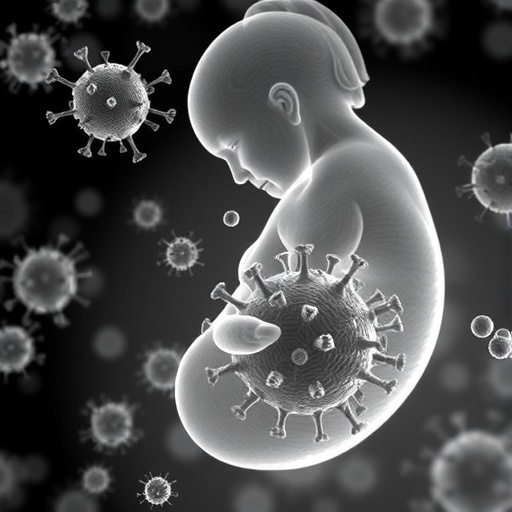In a groundbreaking advancement in cancer biology, researchers have uncovered a pivotal mechanism by which tumor-associated macrophages (TAMs) drive breast cancer progression. This mechanism centers on a long non-coding RNA (lncRNA) dubbed RP11-627G18.1, which appears to be a crucial molecular mediator linking the inflammatory tumor microenvironment to the aggressive metastatic behavior of breast cancer cells. The findings, published recently in Genes and Immunity, provide compelling evidence that lncRNA RP11-627G18.1 is not only induced by TAMs but also actively promotes epithelial-to-mesenchymal transition (EMT), a fundamental cellular program enabling cancer dissemination.
Using sophisticated bioinformatics analyses of tumor microenvironment datasets, Hong, Huang, Ye, and their colleagues systematically screened for lncRNAs associated with TAM infiltration and EMT markers in breast cancer tissues. RP11-627G18.1 emerged consistently as a top candidate, showing strong correlation with gene signatures indicative of EMT, cellular migration, and poor clinical outcomes. This lncRNA had previously been uncharacterized in cancer, prompting comprehensive experimental validation to define its functional significance.
.adsslot_QwC5GtecNR{ width:728px !important; height:90px !important; }
@media (max-width:1199px) { .adsslot_QwC5GtecNR{ width:468px !important; height:60px !important; } }
@media (max-width:767px) { .adsslot_QwC5GtecNR{ width:320px !important; height:50px !important; } }
ADVERTISEMENT
The team employed quantitative reverse transcription PCR (RT-qPCR) to verify that expression of RP11-627G18.1 is robustly upregulated in breast cancer cells co-cultured with TAMs. Notably, exposure to macrophage-conditioned media recapitulated this induction, highlighting that TAM-derived soluble factors likely drive lncRNA expression. This induction coincided temporally with phenotypic changes characteristic of EMT, including downregulation of E-cadherin and upregulation of mesenchymal markers such as vimentin, suggesting a causal linkage.
To dissect the mechanistic role of RP11-627G18.1 in EMT and metastatic capacity, the investigators utilized RNA interference techniques to specifically knock down the lncRNA in breast cancer cell lines. Loss of RP11-627G18.1 markedly reversed the EMT phenotype; epithelial markers were restored while mesenchymal markers diminished. Functionally, this molecular reprogramming translated into significantly impaired migratory capabilities as demonstrated through wound healing and transwell migration assays.
Delving deeper into the protein-level changes, western blot and immunofluorescence analyses revealed that knockdown of RP11-627G18.1 decreased levels of EMT-promoting transcription factors such as Snail and Twist. This strongly indicates that RP11-627G18.1 may act upstream or in concert with these master regulators, integrating extracellular signals from TAMs to activate EMT gene networks. While the exact molecular partners and pathways remain to be fully elucidated, these insights mark a substantial advance in understanding breast cancer plasticity.
The clinical implications of these discoveries are profound. High RP11-627G18.1 expression in patient tumor samples correlated with increased metastasis and worse survival outcomes, underscoring its potential as a prognostic biomarker. Furthermore, the finding that targeting RP11-627G18.1 could abrogate EMT and cellular migration opens up promising therapeutic avenues. Strategies aiming at inhibiting this lncRNA or its downstream effectors may intercept metastatic progression and improve patient prognosis.
This study also enhances the broader appreciation of how non-coding RNAs contribute to tumor-stroma communication. Often overlooked as “junk” DNA, lncRNAs are increasingly recognized as key regulatory elements modulating cancer cell phenotype and behavior in response to the microenvironment. RP11-627G18.1 exemplifies how TAMs co-opt lncRNA circuits to remodel the tumor landscape favorably for cancer dissemination.
Future research is warranted to define the detailed molecular mechanisms through which RP11-627G18.1 mediates these effects. Investigating its interactions with chromatin modifiers, transcription factors, and microRNAs could unravel targeted intervention points. Additionally, exploring whether RP11-627G18.1 influences other hallmarks of cancer such as immune evasion or therapy resistance will broaden its clinical relevance.
Intriguingly, these findings place lncRNA RP11-627G18.1 at the nexus of tumor microenvironment signaling and intrinsic cancer cell plasticity. By decoding this axis, the study contributes to the rational design of precision medicine strategies aiming to dismantle metastatic competency at the RNA level. Therapies tailored to disrupt TAM-induced lncRNA pathways may complement existing modalities and provide durable anti-metastatic effects.
Moreover, the methodological approach adopted—integrating bioinformatics-driven target identification with rigorous in vitro functional assays—sets a new standard for lncRNA research in oncology. It exemplifies how computational and experimental synergy can uncover novel regulatory RNAs with significant clinical impact, accelerating the pipeline of biomarker discovery and therapeutic development.
In summary, the elucidation of TAM-induced lncRNA RP11-627G18.1 as a facilitator of EMT and breast cancer metastasis represents an exciting frontier in cancer immunology and RNA biology. By spotlighting this previously unrecognized lncRNA, the study offers a vital piece of the complex puzzle governing metastatic breast cancer progression. Its translational potential as both a biomarker and a therapeutic target fuels optimism for improved clinical management of this devastating disease.
As the global cancer research community continues to grapple with metastasis as a primary challenge, uncovering such molecular regulators embedded within the tumor ecosystem is crucial. The discovery that tumor-resident immune cells modulate cancer cell behavior through lncRNA intermediaries deepens our mechanistic insight and inspires novel intervention strategies. Ultimately, this work paves the way for lncRNA-targeted therapies that can stymie metastatic spread and improve survival outcomes for millions affected by breast cancer worldwide.
Subject of Research:
The role of tumor-associated macrophage-induced long non-coding RNA RP11-627G18.1 in promoting epithelial-to-mesenchymal transition, migration, and metastasis in breast cancer.
Article Title:
Tumor-associated macrophages-induced lncRNA RP11-627G18.1 promotes breast cancer metastasis.
Article References:
Hong, L., Huang, Y., Ye, F. et al. Tumor-associated macrophages-induced lncRNA RP11-627G18.1 promotes breast cancer metastasis. Genes Immun (2025). https://doi.org/10.1038/s41435-025-00339-1
Image Credits: AI Generated
DOI: https://doi.org/10.1038/s41435-025-00339-1
Tags: bioinformatics in cancer researchbreast cancer research advancementscancer dissemination mechanismsepithelial-to-mesenchymal transition in cancerinflammatory tumor microenvironment impactlncRNA RP11-627G18.1 role in cancer progressionmacrophage-induced cancer cell behaviormechanisms of breast cancer metastasismolecular mediators in cancernon-coding RNAs in tumor biologyTAMs and cancer mortalitytumor-associated macrophages in breast cancer






